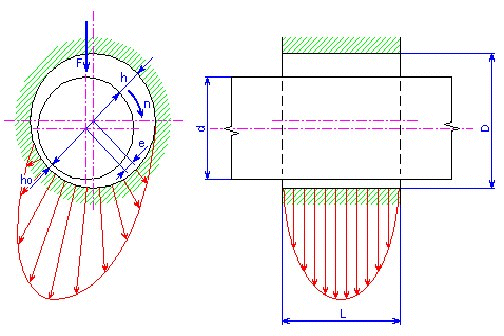Bearings lubricated hydrodynamically are the most important type of plain bearings because full liquid lubrication guarantees their reliable service, without much wear in the end . A lubrication layer is created for these bearings by relative movement of the sliding surfaces. This movement causes lubricant to flow in the lubrication slot due to lubricant adhesion. The supporting layer originates from the V-shaped narrow slot. In this layer, a hydrodynamic pressure field is created in which the resultant must be in equilibrium with the bearing loading force. A hydrodynamic pressure field is displayed in the following picture of a schematic bearing.

Meaning of used variables:
|
d |
Journal diameter [mm] |
|
D |
Bearing diameter [mm] |
|
e |
Journal eccentricity in bearing [μm] |
|
F |
Loading force [N] |
|
h o |
Least thickness of hydrodynamically effective lubrication layer during bearing operation [μm] |
|
L |
Bearing width [mm] |
|
n |
Journal speed [min -1 ] |
The thickness of the lubrication layer depends on the speed of the relative movement of sliding surfaces (the speed of the bearing journal), lubricant viscosity and an active loading force. Because sliding surfaces of machinery parts are never perfectly smooth nor even, their complete separation and subsequent liquid friction only ensures a lubrication layer of a particular minimum thickness which needs a minimum sliding speed for its creation. If this speed is not reached, the bearing operates in maximum friction conditions.
A flow in the hydrodynamic supporting layer is laminar on most bearings. Only during high sliding speeds can a turbulent flow be created. During high journal speeds, its whirling vibration with a half frequency of speed frequency can also occur. To prevent these conditions a bearing check is necessary. It is necessary to check not only for minimum speed at the limit of maximum friction, but also for the maximum speed limit.
The calculation for hydrodynamic radial plain bearings is based on the Reynold equation solution with the consideration of real design and the operating conditions of the bearing. To solve the Reynold equation, many simplifying conditions are used:
- The lubricating liquid is not compressible; flow speed is much lower than the sound speed limit.
- The flow is steady, laminar, and isothermal; lubricating liquid has a consistent density, viscosity, and temperature at all times and in all places.
- The limiting lubricant layer moves at the carrying speed of sliding surfaces.
- The lubricant layer is thin, so the influence of its curvature can be omitted and the layer can be solved by calculating in a straight direction.
- The lubricant layer is filled completely by a lubricant with the same properties.
- The lubricant heaviness and inertial forces in the lubricant layer are negligible.
- The lubricant does not flow in the direction of the lubricant layer thickness, because of a constant pressure in this direction.
- The effect of input pressure to the lubricant pressure field and the effect of negative pressure part of lubricant layer are not taken into account.
- Microgeometric and macrogeometric deviations of the sliding surface forms are transformed into equivalent ideal geometric forms; deviations of mutual position are ignored.
- The bearing parts are ideally rigid, they do not change their size and shape.
- A mean lubricant temperature at the bearing output is taken for the directive temperature for determining a lubricant viscosity for the calculation.
It is necessary to consider into which extent these presumptions are satisfied because bearing parts are not rigid and they do not have ideal forms nor mutual position due to the production, assembly, and operation. Change of lubricant viscosity or even density, mostly due to temperature changes, can result in differences of calculated and real bearing properties. When air and dirt enter into the lubricant layer together with the lubricating liquid, the bearing function can be greatly affected.